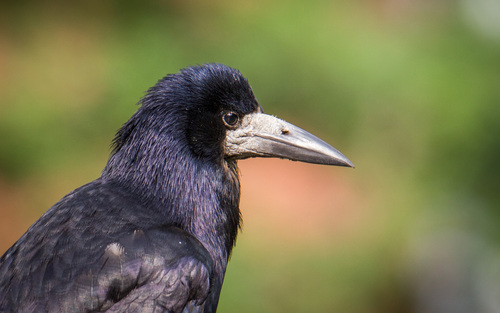
Rook
The Rook (*Corvus frugilegus*) is a member of the Corvidae family, commonly known as the crow family. It is a highly social bird, often seen in large, noisy flocks, particularly during the breeding season and winter. Rooks play an important ecological role as seed dispersers and consumers of invertebrates, impacting agricultural landscapes. While not globally threatened, their populations have experienced declines in some regions due to habitat loss and changes in farming practices. They are a familiar sight across much of Europe and Asia, often associated with rural farmland and open countryside.
44-46 cm
Length
81-99 cm
Wingspan
Least Concern
Conservation Status
Distribution
Rooks are widespread across Europe and Asia. Their range extends from the British Isles and Western Europe eastward across Russia to China and Japan. They are generally absent from the far north (Arctic regions) and the extreme south of Europe and Asia. Migratory patterns vary; western European populations are largely resident, while eastern populations may migrate south for the winter.
Lifespan
Typically 4-5 years in the wild, but can live up to 20 years or more in captivity.
Rook's Habitat
Habitat Types
Agricultural land, Grasslands, Open woodlands, Pastures, Parks
Climate Zones
Temperate, Boreal
Adaptations
Rooks are highly adaptable to various open habitats, favoring areas with a mix of arable land and pasture. Their strong beaks and legs are well-suited for probing the soil for food. Their social behavior also aids in finding and exploiting food resources.
Variations
Two subspecies are generally recognized: *Corvus frugilegus frugilegus* (Western Europe to Central Asia) and *Corvus frugilegus pastinator* (Eastern Asia). *C. f. pastinator* is slightly smaller and has a more feathered base to its bill.
Appearance
Breeding Plumage
Adult plumage is generally consistent year-round.
Seasonal Feather Changes
None
Sex Based Plumage Differences
Males and females have similar plumage.
Notable Features
Black plumage with a glossy sheen (can appear purplish or bluish in good light), Bare, greyish-white skin around the base of the bill in adults, Shaggy 'trousers' (feathers on the legs), Relatively long, pointed bill
Diet and Feeding
Primary Foods
Invertebrates (earthworms, beetles, larvae), Cereals (wheat, barley, oats), Seeds, Fruits, Nuts
Foraging Behavior
Rooks primarily forage on the ground, probing the soil with their beaks to find invertebrates. They often feed in flocks, moving systematically across fields. They also use their bills to turn over stones and debris in search of food.
Specializations
The bare skin at the base of the adult Rook's bill is thought to be an adaptation to prevent feather soiling when probing in the soil.
Seasonal Diet Variations
Their diet varies seasonally. Invertebrates are more important during the breeding season when feeding chicks, while cereals and seeds become a larger part of the diet in autumn and winter.
Behavior
Social Structure
Highly social, forming large colonies called rookeries, especially during the breeding season. Outside of breeding, they often form large communal roosts, sometimes numbering thousands of birds.
Communication
Loud 'caw' calls, Variety of croaks and rattles, Visual displays (bowing, wing-flicking)
Migration
Some populations are migratory, particularly those in eastern Europe and Asia. Western European populations are generally resident.
Territorial or Group Behaviors
Rooks defend their nesting territories within the rookery. They are highly social when foraging and roosting, benefiting from group vigilance against predators.
Conservation
Threats
Habitat loss (due to agricultural intensification and urbanization), Changes in farming practices (reduced availability of invertebrates), Persecution (historically considered an agricultural pest), Pesticide use
Protection Programs
General wildlife protection laws in many countries, Some agri-environment schemes that promote biodiversity
Local National Laws
Protected under various national wildlife laws across its range.
Population Trend
Stable
Population Estimates
The global population is estimated to be between 10,000,000 and 21,999,999 mature individuals.
Interesting Facts
Rooks are known for their intelligence.
They have been observed using tools and solving complex problems in laboratory settings.
Rookeries can be incredibly noisy.
The constant cawing and activity of hundreds or even thousands of birds create a distinctive soundscape.
Rooks sometimes cache food.
They hide food items in the ground or in crevices, retrieving them later.
Juvenile rooks have feathered faces
They lose this feathering as they mature, developing the bare patch around the bill.
Faqs about Rook
How can I tell a Rook from a Crow?
Adult Rooks have a bare, greyish-white patch at the base of their bill, which Carrion Crows lack. Rooks also have shaggier 'trousers' and a more peaked head shape.
Are Rooks harmful to crops?
While Rooks can consume some crops, they also eat many agricultural pests, providing a beneficial service. The balance between damage and benefit is complex and depends on local conditions.
Where do Rooks roost?
Rooks roost communally, often in large numbers, in trees or sometimes on buildings. These roosts can be traditional, used year after year.
What is a group of rooks called?
A group of rooks is called a 'parliament', a 'building', or a 'clamour'.
Copyright @ Nature Style Limited. All Rights Reserved.
 English
English